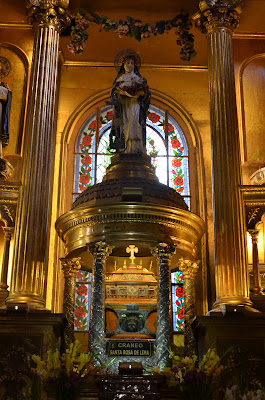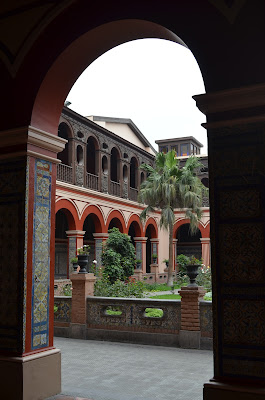In the penitential season of Advent, the church of Rome traditionally kept stations at various churches, where the Pope himself would celebrate the principal Mass, as in the other major penitential season of Lent. The Advent stations, however, were created later than those of Lent, (which are extremely ancient), and differ from them in some key respects. Seven stations are kept at only four churches, namely, St. Mary Major, Holy Cross ‘in Jerusalem’, St. Peter’s and the church of the Twelve Apostles; such repetitions are few and far between in Lent. Apart from the three Ember Days, the ferias of Advent have no proper Mass or station, whereas every day of Lent has both a proper Mass and a station. The churches of Roman martyrs, which predominate on the list of Lenten station, are not included at all in Advent. Most particularly, the connections between the actual texts of the liturgy and the choice of station are far more oblique in Advent, and in some cases, more evident in the Divine Office of the season than they are in the Mass.
The choice of station for the first Sunday is an obvious one, the basilica of St. Mary Major, Rome’s principal and oldest church of the Mother of God. This is also the
station for the Mass of Christmas Eve, and the first Mass of Christmas itself; at a later period, the third Mass was transferred here from its original station at St. Peter’s. The liturgy of Advent looks forward not only to the first coming of Christ as Savior, but also to the Second Coming at the end of the world as Judge. Therefore, the first Gospel of the liturgical year, St. Luke 21, 25-33, in which Christ speaks of the signs that will precede the Second Coming, is read in the same place where the Church will later proclaim His Birth “in the fullness of time”. The Introit of this Mass begins with the words of Psalm 24 “To Thee have I lifted up my soul,” and may perhaps be chosen in reference to the words of the Virgin Mary herself which are said every day at Vespers, “My soul doth magnify the Lord, and my spirit hath rejoiced in God my Savior.” It should also be noted that the Post-communion prayer of this Mass begins with a citation of Psalm 47, the same words that begin the final Mass of the Christmas season as the Introit of the feast of Our Lady’s Purification: “May we receive Thy mercy, o Lord, in the midst of Thy temple.” (They are also sung as the fourth antiphon of Matins on Christmas Day.)
![]() |
| The Annunciation, by Jacopo Torriti, ca. 1295, from the apse of Santa Maria Maggiore. |
As I have described in
another article, in the traditional lectionary of the Roman Rite, (around which much of the stational observance is constructed,) the Gospel of the Annunciation is not read until Advent is more than half over. In the Divine Office, on the other hand, there are several citations of it on the very first day, among them, the antiphons of the
Benedictus and
Magnificat. On the great majority of Sundays, these antiphons are taken from the day’s Gospel; the station at the Virgin Mary’s most important church may be reason why for those of the first Sunday are taken from St. Luke’s account of the Annunciation. This Gospel is also cited in several of the Matins responsories and various antiphons of the first Sunday and week of Advent.
We might expect the station to be held at Holy Cross in Jerusalem on the third Sunday of Advent, since Gaudete Sunday, as it often called, is the Advent parallel of Laetare Sunday in Lent; on the latter, the station is indeed kept there. Instead, the church of Rome visits the relics of the True Cross already on the second Sunday; perhaps, as the Blessed Ildephonse Schuster writes, to remind us that Christ came as man so that He might die as a man for our salvation. (The Sacramentary, vol. 1, p. 323) In many Roman churches, this union of the two holy cities, Jerusalem and Bethlehem, is depicted in the apsidal mosaics, where they are placed on opposite sides at the lowest part, a traditional begun in the mosaics of St. Mary Major.
![]() |
| The Finding of the True Cross by Saint Helena, apsidal fresco of Holy Cross 'in Jerusalem', variously attributed to Antoniazzo Romano or Marco Palmezzano, later 15th century. Notice that the artist has kept to the very ancient Roman tradition of showing the two holy cities on either side of the work; the same motif can be seen in the fifth-century mosaics of Santa Maria Maggiore, and the twelfth-century mosaics of San Clemente. |
The station is referred to in the Introit of the Mass, “O people of Sion, behold the Lord will come to save the nations”, Sion being of course another name for Jerusalem; and likewise in the communion antiphon, a rare citation of the prophet Baruch, “Arise, O Jerusalem, and stand on high, and behold the joy that shall come to thee from thy God.” At Matins of this same Sunday, five of the nine responsories refer to the holy city of Our Lord’s Passion, three of them speaking to it as a person, such as this, the first: “Jerusalem, thy salvation shall swiftly come, why art thou consumed with grief? Hast thou no counselor, that thy sorrow is renewed in thee? I will save thee and deliver thee, fear thou not. For I am the Lord thy God, the Holy One of Israel, thy Redeemer.”
The choice of station for Gaudete Sunday may also seem rather counterintuitive; on the only Sunday whose Introit is taken from the epistles of St. Paul, we might expect it to be kept at the church which guards his tomb, St. Paul’s outside-the-Walls. Instead, the station is kept at St. Peter’s, formerly the station for the principal Mass of Christmas Day; as the church of Rome proclaims “Rejoice in the Lord always; again, I say, rejoice. Let your modesty be known to all men, for the Lord is nigh”, it anticipates the joy of the Savior’s birth in the place where it will be most solemnly celebrated in less than two week’ time.
![]() |
| Saint Paul, holding the sword of his martyrdom, and Saint Peter handing the keys to Pope Eugenius IV (1431-47). These are the central panels of a set of doors made for the old Saint Peter's Basilica by the Florentine sculptor Antonio di Pietro Averlino, usually referred to as "Filarete", Greek for "one who loves excellence." Commissioned by Pope Eugenius, and completed in 1445, they were saved from the demolition of the ancient church in the 16th century and eventually placed in a new frame as the central doors of the new church. Beneath these panels are depicted the deaths of the two Apostles. |
In a certain sense, however, the basilica of St. Peter in the Vatican is also dedicated to St. Paul. The liturgy of Rome always remembers the two Apostles together, not only in their joint feast on June 29th, but also by adding to feasts such as that of Peter’s Chains or the Conversion of Paul a commemoration of the other Apostolic founder of the church in the Eternal City. This tradition was reflected in the art of the old St. Peter’s Basilica, in which nearly every image of St. Peter was accompanied by one of St. Paul. In the modern basilica, on the other hand, there are many images of its titular Saint, but hardly any of St. Paul; its decorative program, conceived in the Counter-Reformation, answers the Protestant rejection of the Pope’s authority by laying much greater emphasis on Peter alone.
The ninth responsory of this Sunday, taken from the beginning of the second chapter of Isaiah, may also be an oblique reference to the station at St. Peter’s. “The Lord will teach us his ways, and we will walk in his paths, for the law shall come forth from Sion, and the word of the Lord from Jerusalem. Come, let us go up to the mountain (ad montem) of the Lord, and to the house of the God of Jacob.” The modern buildings around St. Peter’s, and the massive new basilica itself, largely hide the fact that the Vatican is really a hill; in antiquity, the hills in and around Rome were usually called “mons – mountain” rather than “collis – hill.” The “ways” and “paths” may be a reference to the three ancient roads, Cornelia, Aurelia Nova and Triumphalis, which ran close to the place of St. Peter’s death in the Circus of Nero, and the nearby Vatican Necropolis where he was buried. “The Lord will teach us” and “the law will come forth” would then refer to St. Peter’s God-given role as the first Pope and teacher of the Apostolic faith.
![]() |
| A section of the Forma Urbis Romae by Rodolfo Lanciani (1893-1901), showing the ancient basilica of St. Peter and its conjectured relationship to ancient constructions nearby. The Circus of Nero, where St. Peter was crucified, is shown on the south side of the basilica; its precise size and location are unknown. Modern structures, including the current basilica, are shown in red. |
The stations of the Ember Days are the same in all four seasons of the year, being held on Wednesday at St. Mary Major, Friday at the church of the Twelve Apostles, and on Saturday at St. Peter’s. The Mass of Ember Wednesday commemorates the Incarnation in preparation for the Lord’s Nativity, joining to the Gospel of the Annunciation the famous prophecy of Isaiah that a Virgin shall conceive and bear a Son; the station is therefore most appropriately held at St. Mary Major. The station of Ember Friday at the church of the Twelve Apostles, on the other hand, has no obvious connection to any part of the day’s liturgy; the 12th century liturgical commentator Rupert of Deutz, after noting that the reason behind the choice of station is “quite obscure”, ingeniously finds a reference to it in the Communion of the Mass, “Behold the Lord will come, and all his Saints with Him, and there will be on that day a great light.” “This clearly refers to the glorification of these same Apostles, who will come with Him in the Second Coming unto judgment.” (De Divinis Officiis III, 9)
![]()
The Embertides were originally the privileged season for ordinations, and those of Advent, being the oldest, were once the only season in which Holy Orders were conferred. On Ember Wednesday, a procession of all the clergy and people was held, similar to those which took place every day of Lent, from St. Peter in Chains to St. Mary Major, where the formal announcement was made of those who would be ordained to the priesthood. On Ember Saturdays, five prophecies are read before the Epistle and the Gospel, a total of seven readings. Tonsure was conferred after the Kyrie, and minor orders each after one of the first four readings, porters first, then lectors, exorcists and acolytes. Subdeacons were ordained after the fifth reading, (which is the same on each of the four Ember Saturdays), and deacons after the epistle; priestly ordination was then given after the next-to-last verse of the tract, so that nothing, not even the solemn rites of Holy Orders, may detract from the singing of the Gospel as the culmination of the Mass of the Catechumens. In this case, then, it is not the texts of the Mass or Office that determines the station, nor the station that determines the texts. The station is held at the tomb of the Apostle Peter to express the union of every member of the Roman clergy, from the lowliest porter to the archpriest of the cathedral, with Peter’s successor, the Pope. (
pictured right - St. Peter ordains St. Stephen a Deacon, detail; from the Chapel of Nicolas V by Fra Angelico, 1447-9)
In Rupert of Deutz’s time, no station had been assigned to the fourth Sunday of Advent, a fact which he explains by saying that the mystery of the Incarnation, with which this Sunday is principally occupied, is too great to be entrusted to any one of Christ’s Saints. (ibid., cap. 12). The later addition of a station at the church of the Twelve Apostles, where one had just been held two days before, seems also to be connected to the previous day’s ordinations. In this church, Peter is also honored, but as one of the company of Christ’s closest disciples; their head, to be sure, but as Pope St. Leo the Great writes, the power of the keys “passed also to the other Apostles, and to all the princes of the Church.” (sermon 4, 3) As the Apostles, and those ordained by them, all collaborated in the same mission under the leadership of St. Peter, so do the clergy of Rome, ordained by the Pope, all collaborate with him as their head. Hence also the epistle of this Sunday begins, “Let a man so account of us as of the ministers of Christ, and the dispensers of the mysteries of God.” These ministers and dispensers of the mysteries are the Apostles, and their successors in the clergy; once upon a time, these words were the very first sentence of the Sacred Scriptures to be read at every priest’s first Sunday Mass, at least according to the liturgical use of Rome.
![]() |
| The Tomb of the Apostles Ss. Philip and James, in the crypt of the church of the Twelve Apostles. The church was originally dedicated to just Ss. Philip and James, and later to all Twelve, perhaps in imitation of the Apostoleion of Constantinople. Photograph by Fr. Lawrence Lew, O.P. |
This reading is the beginning of the fourth chapter of I Corinthians, in which St. Paul goes on say “For I think that God hath set forth us Apostles, the last, as it were, men appointed to death: we are made a spectacle to the world, and to angels, and to men. We are fools for Christ's sake … Even unto this hour we both hunger and thirst, and are naked, and are buffeted, and have no fixed abode; and we labor, working with our own hands: we are reviled, and we bless; we are persecuted, and we suffer.” On various feasts of the Apostles, parts of this chapter are read as the epistle; it was later chosen as the Scriptual lesson for the common of Apostles in the Breviary of St. Pius V.
![]()
![]()




























































